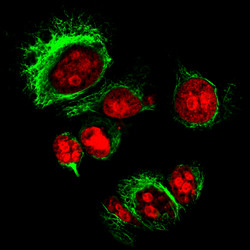Cell architecture in the spotlight
One of the cytoskeleton’s components, the microtubules, is central to the movement of intracellular organelles and to cell division. Microtubules have the intriguing capacity of expanding and retracting their ends, dynamics governed by the specialised microtubule-associated proteins plus-end tracking proteins (+TIPs). Most +TIPs contain a sequence motif, denoted SxIP, that is specifically recognised by the microtubule master organisers, the end binding (EB) proteins. The scope of the EU-funded EB-SXIP (Modulating EB protein interactions through small molecules) project was to dissect the mechanism by which microtubule associated proteins (+TIPS and EB) interact, and to identify small molecule inhibitors. Ultimately the goal was to unravel which cellular processes are dependent on this interaction and on the +TIPS protein network. For this purpose, researchers combined computational, structural, cell and chemical biology methods and established collaborations all over Europe. To identify inhibitors of the EB-SxIP interaction, they developed a fluorescence polarisation quantitative assay and elucidated the sequence determinants, binding activity and regulation of different human +TIPs. Next, scientists generated EB mutants that disrupted SxIP binding while keeping intact the ability of EBs to track growing microtubules. This disruption caused defects in mitotic spindle formation but nonetheless, cells successfully progressed through the cell cycle. Collectively, the EB-SXIP study provided unprecedented information on the molecular recognition mechanisms of the cytoskeleton and their modes of regulation. This is necessary to understand how cytoskeleton protein networks within the cell translate into cellular functions. Furthermore, the generated data could serve as the basis for future genome-wide analyses that could predict the existence of novel +TIPs in other organisms. Given the involvement of EB proteins in various malignancies, these results could also have therapeutic relevance.







